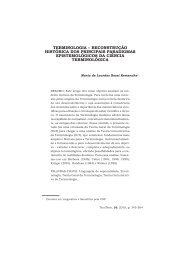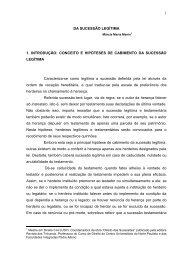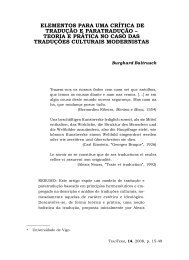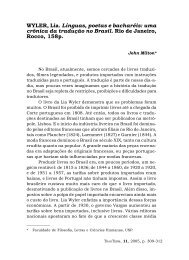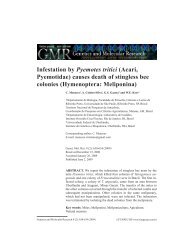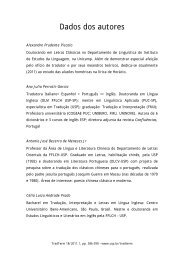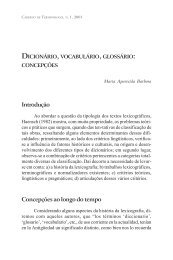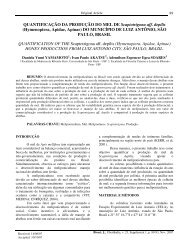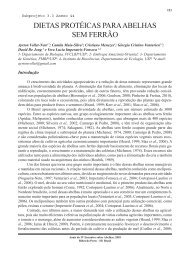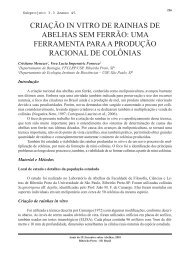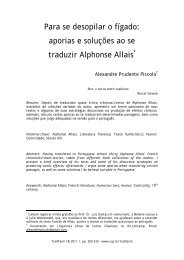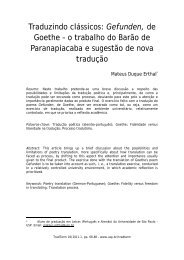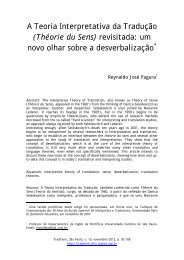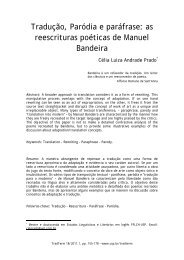Bees as pollinators in Brazil - USP
Bees as pollinators in Brazil - USP
Bees as pollinators in Brazil - USP
Create successful ePaper yourself
Turn your PDF publications into a flip-book with our unique Google optimized e-Paper software.
F<strong>in</strong>al considerations<br />
regard<strong>in</strong>g solitary bees<br />
1. Me<strong>as</strong>ur<strong>in</strong>g effectiveness of methods<br />
for population <strong>in</strong>cre<strong>as</strong>e<br />
a. The only practical species to manage are<br />
those whose populations can be <strong>in</strong>cre<strong>as</strong>ed<br />
(more daughters than mothers).<br />
b. Methods that produce populations with<br />
limited par<strong>as</strong>ites and dise<strong>as</strong>e.<br />
c. Affordable nest<strong>in</strong>g materials that are practi-<br />
cal to make and endure for Xylocopa and<br />
Megachile; there is a possibility of adaptation<br />
of exist<strong>in</strong>g methods.<br />
2. Greenhouse poll<strong>in</strong>ation<br />
The ma<strong>in</strong> difficulty <strong>in</strong> us<strong>in</strong>g solitary bees <strong>as</strong><br />
<strong>poll<strong>in</strong>ators</strong> <strong>in</strong> greenhouses is that gl<strong>as</strong>s and<br />
pl<strong>as</strong>tic absorb UV, which <strong>in</strong>terferes with bee<br />
orientation dur<strong>in</strong>g flight. How to me<strong>as</strong>ure<br />
their poll<strong>in</strong>ation efficiency <strong>in</strong> greenhouses is<br />
not relevant; at this stage it is known which<br />
species can be used.<br />
3. Stimulat<strong>in</strong>g people to get<br />
<strong>in</strong>volved <strong>in</strong> rear<strong>in</strong>g and sell<strong>in</strong>g<br />
solitary bees.<br />
Stimulate small growers who probably will<br />
own their own bees; to show the results the<br />
growers can have when they use the poll<strong>in</strong>a-<br />
tors (<strong>in</strong> numbers, value, amount of profit).<br />
We only have to conv<strong>in</strong>ce about 1% of<br />
them; the rest will be very rapidly conv<strong>in</strong>ced<br />
once they see the profits of the neighbours.<br />
As it is not common <strong>in</strong> <strong>Brazil</strong> to value polli-<br />
nation services, and bees <strong>in</strong> general, espe-<br />
cially solitary bees, it is important to dissem-<br />
<strong>in</strong>ate <strong>in</strong>formation (about simple concepts<br />
such <strong>as</strong> poll<strong>in</strong>ation, <strong>poll<strong>in</strong>ators</strong>, their services,<br />
etc.), distributed by extension programs (for<br />
example <strong>in</strong> small scale plant<strong>in</strong>gs of<br />
P<strong>as</strong>siflora).<br />
F<strong>in</strong>al considerations<br />
regard<strong>in</strong>g Bombus<br />
1. No importation of non-native species<br />
There should be regulation on importation of<br />
bees:<br />
• brazilian laws must be made controll<strong>in</strong>g<br />
Bombus importation;<br />
• seek an agreement among South American<br />
countries or <strong>in</strong> the Mercosul related to bum-<br />
blebees importation;<br />
• establish a monitor<strong>in</strong>g program of <strong>in</strong>v<strong>as</strong>ive<br />
Bombus terrestris from Uruguay. This<br />
species w<strong>as</strong> <strong>in</strong>troduced <strong>in</strong>to Uruguay <strong>in</strong><br />
1995 and now is free-liv<strong>in</strong>g <strong>in</strong> nature, colo-<br />
niz<strong>in</strong>g new are<strong>as</strong> and spread<strong>in</strong>g towards<br />
the <strong>Brazil</strong>ian border.<br />
2. Need for importation of non-native<br />
Bombus species<br />
There is no need for importation, because:<br />
• these bee species are used only for poll<strong>in</strong>a-<br />
tion of greenhouse crops;<br />
• they are used ma<strong>in</strong>ly for tomato poll<strong>in</strong>ation,<br />
but recent studies have shown that native<br />
st<strong>in</strong>gless bees Melipona quadrif<strong>as</strong>ciata and<br />
Nannotrigona pirilampoides are good toma-<br />
to poll<strong>in</strong>ator <strong>in</strong> greenhouses;<br />
• exotic Bombus species may br<strong>in</strong>g par<strong>as</strong>ites<br />
and dise<strong>as</strong>es to native species.<br />
3. Us<strong>in</strong>g native Bombus species for crop<br />
poll<strong>in</strong>ation<br />
We do not currently have knowledge to han-<br />
dle native Bombus. If it is go<strong>in</strong>g to be used,<br />
research is needed on biology and rear<strong>in</strong>g<br />
methods. Two species are promis<strong>in</strong>g:<br />
• B. atratus - not so aggressive when <strong>in</strong> small<br />
colonies;<br />
Workshop I 61<br />
• B. brevivillus - <strong>in</strong> Northe<strong>as</strong>t <strong>Brazil</strong>, not<br />
aggressive; h<strong>as</strong> potential <strong>as</strong> a poll<strong>in</strong>ator of<br />
crops of gl<strong>as</strong>shouses and <strong>in</strong> open are<strong>as</strong>.



